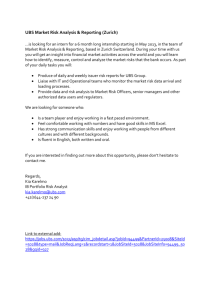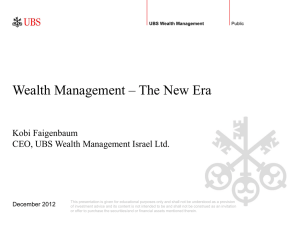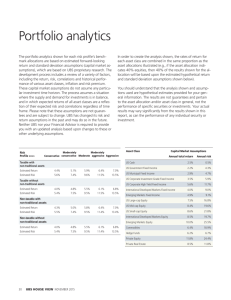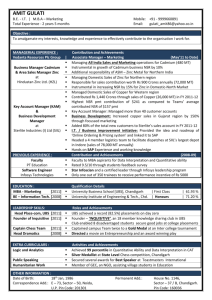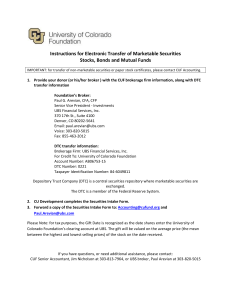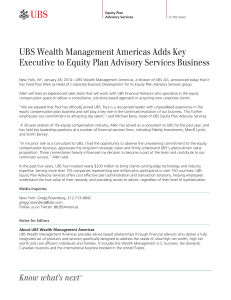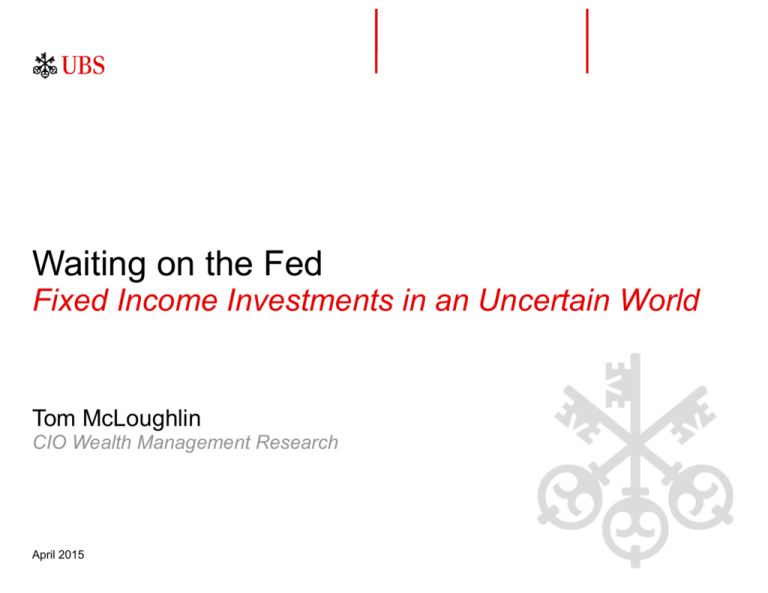
Waiting on the Fed
Fixed Income Investments in an Uncertain World
Tom McLoughlin
CIO Wealth Management Research
April 2015
An uncertain world …
Uneven
economic
growth
Divergent
monetary
policies
Inconsistent
fiscal policies
Competing
labor forces
Geopolitical
tensions
Increased
volatility
Source: UBS CIO WMR, as of April 2015
1
The big picture: the Fed is keenly aware of the fact that …
Global growth remains uneven
Monetary policies around the world are diverging
Geopolitical risks are on the rise in the Eurozone, Russia, and the Middle
East
Currency values are moving in different directions, and
Demand for labor is evolving as the economy is buffeted by technological
change
Let's take a closer look at the last item a little more
closely …
Source: UBS CIO WMR, as of April 2015
2
Technology adoption is faster
Time to reach 50 million users
Telephone
75 years
Radio
38 years
TV
Internet
Facebook
Angry birds
13 years
4 years
3.5 years
35 days
Source: Citigroup Global Perspectives, UBS CIO WMR, as of April 2015
3
Triggering some creative destruction
In music …
Music sales on physical media
2004
2008
800M units
$12.3B in sales
400M units
$7.4B in sales
Source: Brynjolfsson and McAfee, The Second Machine Age, UBS CIO WMR, as of April 2015
4
Creative destruction
In books …
Barnes & Noble
NYC Flagship
store : 40,000
titles
Amazon.com
2,000,000 titles
Source: Brynjolfsson and McAfee, The Second Machine Age, UBS CIO WMR, as of April 2015
5
Creative destruction
In photography …
Through 2014, there were 3.5 trillion photographs taken since the first image
was captured in Paris in 1838
10% of that total were taken in the last 12 months
Eastman Kodak employed 145,300 employees and had a market share of
90% at its peak
The company invented the digital camera in 1975 but shelved the idea
Today 2.5 billion people have the capability of taking digital photographs and
Kodak is a shadow of its former self
Source: Brynjolfsson and McAfee, The Second Machine Age, UBS CIO WMR, as of April 2015
6
Economic Drivers in an Era of Accelerating Technological Change
Intellectual property
• Patents
• Copyrights
Efficiency
Business model
• Automation – auto assembly
• Self service – airline check-
• User generated content
− Yelp, Trip Advisor
• On-line delivery of services
− Amazon.com
in
• Mobility – RFID, airline bag
tags
Source: UBS CIO WMR, as of April 2015
7
Creating winners and losers
1990
2015
Big 3 Automakers
Big 3 Tech Companies
Employees:
Employees:
1.2 million
137,000
Market Cap:
Market Cap:
$36B
$1.3T
Source: Citigroup Global Perspectives, UBS CIO WMR, as of April 2015
8
Are we measuring economic activity properly?
Question
How much would you pay (or more accurately, would have paid)
for services now available for free on the Internet?
Answer
In a McKinsey survey, the answer was: $50 per month or an
estimated $35 billion annually.
Source: Brynjolfsson and McAfee, The Second Machine Age, UBS CIO WMR, as of April 2015
9
Squeezing the middle class and altering labor demand
In high demand
Engineers
Plumbers
Electricians
Dentists
Gardeners
Source: UBS CIO WMR, as of April 2015
In less demand
Bookkeepers
Bank tellers
Billing clerks
Telephone operators
Assembly line workers
10
Factors driving rates in the United States
•
•
•
•
•
•
Subdued inflation
The flight to safety
A strengthening dollar
ECB engages in QE
Portfolio rebalancing
Harsh winter slows growth
• Unemployment rate falls
• Private sector job creation
Source: UBS CIO WMR, as of April 2015
11
A low inflation rate encourages patience by the Fed
Source: Bloomberg, UBS CIO WMR, as of 31 March 2015
12
And crude oil prices decline, a net positive for the US
Crude remains under pressure
WTI crude price
North American oil production
In 1,000 barrels per day
160
10,000
9,000
140
8,000
120
7,000
100
6,000
80
5,000
4,000
60
3,000
40
2,000
20
1,000
0
1990
1995
2000
2005
2010
2015
Source: Bloomberg, UBS CIO WMR, as of 8 April 2015
0
2000
2003
2006
2009
2012
2015
13
But alters the outlook for the Eurozone, Russia, and Middle
East
Russian equity market and the ruble
Historical levels
Great default looms, exit risk moderate but rising
Greek 10-year government bond yield
13
1600
3.5
1400
3.0
1200
2.5
1000
2.0
800
1.5
12
11
10
9
8
7
6
5
Jan-14
Apr-14
Jul-14
Oct-14
Jan-15
Apr-15
Source: Bloomberg, UBS CIO WMR, as of 8 April 2015
1.0
600
Jan-14 Apr-14 Jul-14 Oct-14 Jan-15 Apr-15
RTS index (lhs)
14
Meanwhile, while central bank assets have increased …
Total assets of global central banks
$ in billions
16,000
14,000
12,000
10,000
8,000
6,000
4,000
2,000
0
2005
PBoC
2007
ECB
Fed
2009
2011
2013
2015
BoJ
Source: Bloomberg, UBS CIO WMR, as of 8 April 2015
15
… global monetary policies are now diverging
Source: UBS Investment Research, UBS CIO WMR, as of 31 March 2015
16
The economic expansion in the US appears durable …
Payrolls have continued to trend higher despite the recent data
US non-farm payrolls
600
400
200
0
(200)
(400)
(600)
(800)
(1000)
2008
2009
Non farm payrolls
2010
2011
2012
2013
2014
2015
12 month moving average
Source: Bloomberg, UBS CIO WMR, as of 8 April 2015
17
… and puts the Fed is on path towards normalization
Government bond yield curves
3.0
2.5
2.0
1.5
1.0
0.5
0.0
(0.5)
3M
6M
US
1Y
Germany
2Y
Japan
Source: Bloomberg, UBS CIO WMR, as of 8 April 2015
3Y
5Y
7Y
10Y
30Y
Italy
18
… leaving the front end of the curve more exposed …
3.0
Yield to maturity (%)
2.5
2.0
1.5
1.0
0.5
0.0
0
5
Spot
10
Fwd (3mo)
Source: UBS CIO WMR, as of 20 March 2015
15
Maturity (years)
Fwd (6mo)
20
Fwd (9mo)
25
30
Fwd (1yr)
19
… as investors expect the Treasury curve to flatten
1yr forward curve today vs. spot curve on 9/5/2013
Yield to maturity (%)
4
3.5
3
2.5
2
1.5
1
0.5
0
2yr
5yr
10yr
30yr
Maturity (years)
9/5/2013
3/25/2016
Source: UBS CIO WMR, as of 26 March 2015
20
Total return by fixed income sector
Total Return
In %
S&P 500
Taxable FI Agg
Munis
Build America Bonds
Emerging Markets
Preferreds
High Yield
Investment Grade
Agencies
TIPs
Treasuries
-10%
-5%
0%
2015 YTD TR
5%
10%
15%
20%
2014 TR
Source: BofAML, Bloomberg, UBS CIO WMR, as of 6 April 2015
21
Yields have continued to trend lower
10 year Treasury yields
Average yield per year, in %
12
10
8
6
4
2
0
1980
1985
1990
1995
Source: Bloomberg, UBS CIO WMR, as of 8 April 2015
2000
2005
2010
2015
22
Biggest challenge: where to find income?
Yield-to-worst
Yield, in percent
7
6
5
4
3
2
1
0
(1)
Source: BofAML, UBS CIO WMR, as of 6 April 2015
23
The zero rate policy fuels higher volatility …
Volatility levels and Average over the past 12 years
The number of times volatility has risen above the average has been greater post crisis
250
13.4
12.4
Post Crisis
Pre-Crisis
11.4
200
10.4
9.4
8.4
150
7.4
6.4
5.4
100
4.4
3.4
2.4
50
Mar-03
Mar-04
Mar-05
MOVE Index
Mar-06
Mar-07
Mar-08
Mar-09
MOVE Index AVG
Source: Bloomberg, UBS CIO WMR, as of 9 February 2015
Mar-10
Mar-11
10-Year Treas Vol
Mar-12
Mar-13
Mar-14
1.4
Mar-15
10-Year Vol Avg
24
… but the next tightening cycle should be more gradual
Inflation rate is more subdued than in past
7
1
6
0.9
5
0.8
4
0.7
3
0.6
2
0.5
1
0.4
0
0.3
-1
0.2
-2
0.1
-3
1990
0
1992
1994
1996
Tightening cycles
1998
2000
2002
CPI YOY
Source: Bloomberg, UBS CIO WMR, as of 7 April 2015
2004
2006
2008
2010
2012
2014
Avg. Fed tightening cycle inflation rate
25
… and a slower rise in rates should boost fixed income returns
Total return of various fixed income spread product during the actual dates of tightening
using 1,2, and 3 year projections with rising rates and fed funds
20
16
12
8
4
0
-4
1994 Hikes
1999 Hikes
US Treas
2004 Hikes
IG Corp
Source: UBS CIO WMR, as of 20 March 2015
Proj. 1yr
HY Invest
Proj.2yr
MBS
Proj. 3yr
Preferred
26
Our Outlook: "Will, Won't, Might"
• Will happen
− Global growth continues, led mainly by developed economies
− The Fed tightens gradually while other central banks ease
− The US dollar strengthen just a little more – then trades in a narrow range
− European equities get a boost from a lower euro
• Won't happen
− Inflation becomes a global problem
− The Federal Reserve tightens monetary policy too soon, too much, too fast
− The S&P 500 delivers better than average returns without volatility
• Might happen
− Structural reforms in EM lead to better earnings outlook & investor sentiment
− Long-term interest rates don't budge even if Fed raises the short end
− European economic growth accelerates, providing support to the euro
Source: UBS CIO WMR, as of 31 March 2015
27
Preferred investment views
Most preferred
Equities
Fixed income
Foreign exchange
Least preferred
•
•
•
•
•
•
US small caps
Eurozone
The rising Millennials
E-Commerce
US capex
Cancer therapeutics
• Emerging Markets ()
• UK ()
•
•
•
•
•
US high yield
US investment grade
Mortgage IOs
US senior loans
Beyond benchmark fixed income
investing
• Government bonds ()
Portfolio weightings
Source: WMA Asset Allocation Committee (AAC) and UBS
CIO WMR, as of 23 April 2015
• USD
• EUR
Note: Portfolio weightings are for USD-based
moderate risk profile, taxable account For portfolio
weights related to other risk profiles please see
the flagship publication UBS House View.
Alternative
investments
Cash
Source: UBS CIO WMR
Recent upgrades
Recent downgrades
28 28
Please see important disclaimer and disclosures at the end of the document.
Important Information
It is important that you understand the ways in which we conduct business and the applicable laws and regulations that govern us. As a firm providing wealth management
services to clients, we are registered with the U.S. Securities and Exchange Commission (SEC) as an investment adviser and a broker-dealer, offering both investment
advisory and brokerage services. Though there are similarities among these services, the investment advisory programs and brokerage accounts which we offer are separate
and distinct, differ in material ways and are governed by different laws and separate contracts.
It is important that you carefully read the agreements and disclosures that we provide to you about the products or services we offer. While we strive to ensure the nature of
our services is clear in the materials we publish, if at any time you seek clarification on the nature of your accounts or the services you receive, please speak with your Private
Wealth Advisor. For more information, please visit our website at www.ubs.com/workingwithus.
UBS Wealth Management Research
Two sources of research are available to clients of UBS Financial Services Inc. Reports from the first source, UBS Wealth Management Research, are designed primarily for
use by individual investors and are produced by UBS Wealth Management Americas (the UBS business group that includes, among others, UBS Financial Services Inc.) and
UBS Wealth Management & Swiss Bank. The second source is UBS Investment Research, and its reports are produced by UBS Investment Bank, whose primary business
focus is institutional investors. The two sources may have different opinions and recommendations. The various research content provided does not take into account the
unique investment objectives, financial situation or particular needs of any specific individual investor. If you have any questions, please consult your Private Wealth Advisor.
UBS Wealth Management Research is provided by UBS Financial Services Inc. and UBS AG. UBS Financial Services Inc. is a subsidiary of UBS AG.
Sources of strategic asset allocations and investor risk profiles
Strategic asset allocations represent the longer-term allocation of assets that is deemed suitable for a particular investor. The strategic asset allocation models discussed in
this publication, and the capital market assumptions used for the strategic asset allocations, were developed and approved by the WMA AAC.
The strategic asset allocations are provided for illustrative purposes only and were designed by the WMA AAC for hypothetical US investors with a total return objective under
five different Investor Risk Profiles ranging from conservative to aggressive. In general, strategic asset allocations will differ among investors according to their individual
circumstances, risk tolerance, return objectives and time horizon. Therefore, the strategic asset allocations in this publication may not be suitable for all investors or investment
goals and should not be used as the sole basis of any investment decision. Minimum net worth requirements may apply to allocations to non-traditional assets. As always,
please consult your UBS Financial Advisor to see how these weightings should be applied or modified according to your individual profile and investment goals.
The process by which the strategic asset allocations were derived is described in detail in the publication entitled “UBS WMA’s Capital Markets Model: Explained, Part II:
Methodology,” published on 22 January 2013. Your Financial Advisor can provide you with a copy.
Deviations from strategic allocation
The recommended tactical deviations from the strategic asset allocation are provided by the Global Investment Committee and the Investment Strategy Group within Wealth
Management Research Americas. They reflect the short- to medium-term assessment of market opportunities and risks in the respective asset classes and market segments.
Positive / zero / negative tactical deviations correspond to an overweight / neutral / underweight stance for each respective asset class and market segment relative to their
strategic allocation. The current allocation is the sum of the strategic asset allocation and the tactical deviation.
Note that the regional allocations on the International Equities page are provided on an unhedged basis (i.e., it is assumed that investors carry the underlying currency risk of
such investments). Thus, the deviations from the strategic asset allocation reflect the views of the underlying equity and bond markets in combination with the assessment of
the associated currencies. The two bar charts (“Equity regions” and “Bond regions”) represent the relative attractiveness of countries (including the currency outlook) within a
pure equity and pure fixed income portfolio, respectively. In contrast, the detailed asset allocation tables integrate the country preferences within each asset class with the
asset class preferences stated earlier in the report.
29
Disclaimer
Chief Investment Office (CIO) Wealth Management (WM) Research is published by UBS Wealth Management and UBS Wealth Management Americas, Business Divisions of
UBS AG (UBS) or an affiliate thereof. CIO WM Research reports published outside the US are branded as Chief Investment Office WM. In certain countries UBS AG is
referred to as UBS SA. This publication is for your information only and is not intended as an offer, or a solicitation of an offer, to buy or sell any investment or other specific
product. The analysis contained herein does not constitute a personal recommendation or take into account the particular investment objectives, investment strategies,
financial situation and needs of any specific recipient. It is based on numerous assumptions. Different assumptions could result in materially different results. We recommend
that you obtain financial and/or tax advice as to the implications (including tax) of investing in the manner described or in any of the products mentioned herein. Certain
services and products are subject to legal restrictions and cannot be offered worldwide on an unrestricted basis and/or may not be eligible for sale to all investors. All
information and opinions expressed in this document were obtained from sources believed to be reliable and in good faith, but no representation or warranty, express or
implied, is made as to its accuracy or completeness (other than disclosures relating to UBS and its affiliates). All information and opinions as well as any prices indicated are
current only as of the date of this report, and are subject to change without notice. Opinions expressed herein may differ or be contrary to those expressed by other business
areas or divisions of UBS as a result of using different assumptions and/or criteria. At any time, investment decisions (including whether to buy, sell or hold securities) made by
UBS AG, its affiliates, subsidiaries and employees may differ from or be contrary to the opinions expressed in UBS research publications. Some investments may not be
readily realizable since the market in the securities is illiquid and therefore valuing the investment and identifying the risk to which you are exposed may be difficult to quantify.
UBS relies on information barriers to control the flow of information contained in one or more areas within UBS, into other areas, units, divisions or affiliates of UBS. Futures
and options trading is considered risky. Past performance of an investment is no guarantee for its future performance. Some investments may be subject to sudden and large
falls in value and on realization you may receive back less than you invested or may be required to pay more. Changes in FX rates may have an adverse effect on the price,
value or income of an investment. This report is for distribution only under such circumstances as may be permitted by applicable law.
Distributed to US persons by UBS Financial Services Inc., a subsidiary of UBS AG. UBS Securities LLC is a subsidiary of UBS AG and an affiliate of UBS Financial Services
Inc. UBS Financial Services Inc. accepts responsibility for the content of a report prepared by a non-US affiliate when it distributes reports to US persons. All transactions by a
US person in the securities mentioned in this report should be effected through a US-registered broker dealer affiliated with UBS, and not through a non-US affiliate. The
contents of this report have not been and will not be approved by any securities or investment authority in the United States or elsewhere.
UBS specifically prohibits the redistribution or reproduction of this material in whole or in part without the prior written permission of UBS and UBS accepts no liability
whatsoever for the actions of third parties in this respect.
Version as per May 2014.
© UBS 2015. The key symbol and UBS are among the registered and unregistered trademarks of UBS. All rights reserved.
30

